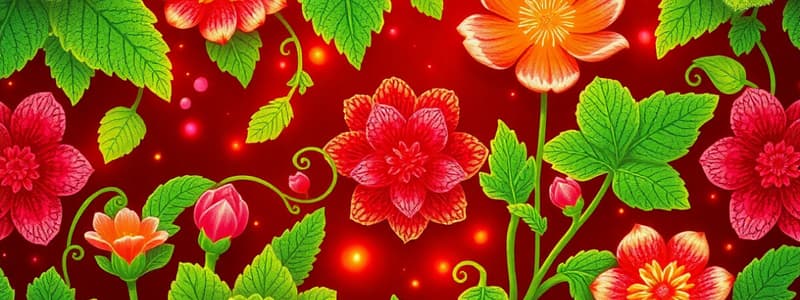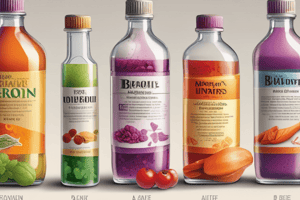Podcast
Questions and Answers
What happens to chlorophyll during canning processes?
What happens to chlorophyll during canning processes?
- It increases the acidity of the canned product
- Artificial colors are often added to compensate for its loss (correct)
- It enhances the flavor of the product
- It completely retains its original structure
What effect does adding sodium bicarbonate to cooking water have on chlorophyll?
What effect does adding sodium bicarbonate to cooking water have on chlorophyll?
- It enhances the formation of chlorophyll
- It has no significant effect on chlorophyll
- It preserves the texture and flavor of the vegetables
- It promotes the formation of pheophytins and reduces vitamin C (correct)
Which of the following substances is being studied as a potential food color alternative to tartrazine?
Which of the following substances is being studied as a potential food color alternative to tartrazine?
- Lycopene
- Beta-carotene
- Sodium copper chlorophyllin (correct)
- Synthetic chlorophyll
Which of the following accurately describes carotenoids?
Which of the following accurately describes carotenoids?
What is the simplest carotene mentioned in the content?
What is the simplest carotene mentioned in the content?
What are xanthophylls primarily known for?
What are xanthophylls primarily known for?
Which carotenoid is primarily responsible for the yellow color in various foods?
Which carotenoid is primarily responsible for the yellow color in various foods?
What is crocetin primarily associated with?
What is crocetin primarily associated with?
What effect does heat have on carotenoids?
What effect does heat have on carotenoids?
Anthocyanins are primarily responsible for which colors in plants?
Anthocyanins are primarily responsible for which colors in plants?
Which of the following foods contains astaxanthin?
Which of the following foods contains astaxanthin?
Which compound can irreversibly bleach anthocyanins at high concentrations?
Which compound can irreversibly bleach anthocyanins at high concentrations?
What type of interactions can cause unusual color changes in canned fruit?
What type of interactions can cause unusual color changes in canned fruit?
What is a significant health benefit associated with carotenoids found in fruits and vegetables?
What is a significant health benefit associated with carotenoids found in fruits and vegetables?
What distinguishes anthocyanidins from anthocyanins?
What distinguishes anthocyanidins from anthocyanins?
Which ingredient would be most appropriate for color enhancement in dairy products?
Which ingredient would be most appropriate for color enhancement in dairy products?
What is a key distinguishing characteristic of betacyanins compared to anthocyanins?
What is a key distinguishing characteristic of betacyanins compared to anthocyanins?
What causes the brown coloration on the cut surfaces of apples?
What causes the brown coloration on the cut surfaces of apples?
Why are betalains unsuitable for coloring cakes?
Why are betalains unsuitable for coloring cakes?
Which statement about anthocyanins is correct?
Which statement about anthocyanins is correct?
What common substrate for polyphenol oxidase is found in many fruits such as apples and pears?
What common substrate for polyphenol oxidase is found in many fruits such as apples and pears?
What role do synthetic dyes play in modern confectionary and soft drinks?
What role do synthetic dyes play in modern confectionary and soft drinks?
Which of the following is true about melanin in plants?
Which of the following is true about melanin in plants?
What color do anthocyanins typically exhibit in acidic environments?
What color do anthocyanins typically exhibit in acidic environments?
Which characteristic differentiates anthocyanins from betalains?
Which characteristic differentiates anthocyanins from betalains?
Flashcards
Chlorophyll Degradation
Chlorophyll Degradation
A process where magnesium is lost from chlorophyll molecules, resulting in the formation of brown pheophytins, which are responsible for the dull, brown color often seen in cooked vegetables.
Alkalinity and Chlorophyll
Alkalinity and Chlorophyll
Adding sodium bicarbonate to cooking water helps to neutralize the acidity, slowing down the chlorophyll degradation process. This helps preserve the vibrant green color of vegetables during cooking.
Pheophytins
Pheophytins
Pheophytins are brown pigments formed when magnesium is lost from chlorophyll molecules due to heat or acidity.
Carotenoids
Carotenoids
Signup and view all the flashcards
Lycopene
Lycopene
Signup and view all the flashcards
Xanthophyll
Xanthophyll
Signup and view all the flashcards
Hydroxylation of carotenes
Hydroxylation of carotenes
Signup and view all the flashcards
Saffron
Saffron
Signup and view all the flashcards
Annatto
Annatto
Signup and view all the flashcards
Astaxanthin
Astaxanthin
Signup and view all the flashcards
Isomerization of trans-double bonds in carotenes
Isomerization of trans-double bonds in carotenes
Signup and view all the flashcards
Anthocyanins
Anthocyanins
Signup and view all the flashcards
Anthocyanidins
Anthocyanidins
Signup and view all the flashcards
Cyanidin
Cyanidin
Signup and view all the flashcards
Anthocyanin pH Effect
Anthocyanin pH Effect
Signup and view all the flashcards
Betalains
Betalains
Signup and view all the flashcards
Betalain Types
Betalain Types
Signup and view all the flashcards
Betalain pH Stability
Betalain pH Stability
Signup and view all the flashcards
Melanins
Melanins
Signup and view all the flashcards
Enzymatic Browning
Enzymatic Browning
Signup and view all the flashcards
Chlorogenic Acid
Chlorogenic Acid
Signup and view all the flashcards
Preventing Browning
Preventing Browning
Signup and view all the flashcards
Browning in Animals
Browning in Animals
Signup and view all the flashcards
Study Notes
Food Colorants
- Color is crucial for food appreciation and quality assessment
- Food industry prioritizes maintaining original raw material colors in processed foods
- Some foods' colors change due to processing (e.g., browning of cake, curing of meat)
- Consumer concern exists regarding the use of synthetic food colorants
Chlorophylls
- Chlorophyll is a green pigment found in leafy vegetables, green apple skin, and unripe fruits
- Chlorophyll plays a vital role in photosynthesis within plant cells, specifically within chloroplasts
- Chlorophylls a and b are porphyrins similar to hemoglobin, but contain magnesium instead of iron
- Chlorophyll is lost naturally during leaf senescence due to chlorophyllase
- When green vegetables are heated, the magnesium in chlorophyll is lost, leading to the formation of pheophytins (a and b). This results in a brownish color
- The acidity of plant cell vacuoles promotes pheophytin formation during cooking
- Keeping the cooking water alkaline (with sodium bicarbonate) is somewhat effective, but also decreases vitamin C and impacts texture and flavor
- In canning peas, chlorophyll loss is common, so artificial colours (like tartrazine and Green S) are added.
- Growing concern regarding tartrazine safety has led to evaluating alternative and safer chlorophyll derivatives as food colors (e.g., sodium copper chlorophyllin)
- Sodium copper chlorophyllin is blue-green and survives the canning process, while copper content is too low to be a health risk.
Carotenoids
- Carotenoids are responsible for the yellow and orange colors in fruits and vegetables
- They are found in chloroplasts
- Classified as terpenoids
- Two main groups: carotenes (hydrocarbons, simplest being lycopene), and xanthophylls (contain oxygen)
- Xanthophylls are created by hydroxylation of carotenes
- Xanthophylls are the dominant pigment in yellow tissues, while carotenes give an orange color
- Examples of carotenoids include crocetin (found in saffron) and bixin (found in annatto, a component of cheddar cheese)
- Carotenoids are relatively stable to heat, but isomerization to cis forms can occur with heating
- Epidemiological studies suggest that consumption of fruits and vegetables rich in carotenoids (e.g., a- and β-carotene, lutein, lycopene) may reduce the risk of certain cancers (e.g., lung and prostate cancer).
Anthocyanins
- Anthocyanins produce pink, red, mauve, violet, and blue colours in flowers, fruits, and vegetables
- They are flavonoids, located in vacuoles within plant cells
- Naturally found as glycosides (with sugars attached)
- Aglycones (sugar-free counterparts) are anthocyanidins (e.g., cyanidin, pelargonidin, delphinidin)
- Anthocyanins complex with metal cations, possibly altering color in canned fruit due to interactions with the metal of the can or container.
- Reactions with sulfur dioxide, a popular preservative in wines/fruit juices, can lead to irreversible fading or bleaching of anthocyanin colours
- Anthocyanin colours are pH-dependent, changing from red to pink to purple/blue, depending on the acidity/alkalinity of the environment.
Betalains
- Beetroot pigments, exhibiting reddish-purple colours.
- Two main groups: betacyanins (purplish red, similar to anthocyanins), and betaxanthines (yellow, less common)
- Beetroot extract is sometimes used as a food colourant, but its heat instability makes it unsuitable for colouring cakes.
Melanins
- Melanins are undesirable brown pigments in damaged plant tissues leading to undesirable browning
- Browning arises when plant tissues are damaged/exposed to air, triggering an enzymatic browning process involving phenolase (or polyphenol oxidase) which oxidizes polyphenolic compounds.
- Prevention of browning can be achieved with blanching/reducing air exposure through immersion
- Chlorogenic acid is a frequently encountered substrate for phenolase in apples, pears, and potatoes.
- In animal tissues, tyrosine is the only substrate for polyphenol oxidase.
- Adding chelating agents, using organic acids (like citric/malic acid), and using sulfur dioxide are ways to inhibit phenolase activity and prevent undesirable browning.
Tea
- Tea leaves have high polyphenol content (over 30%)
- Caffeine (3-4% of dry weight) is a key component
- Tea processing (withering, fermentation, firing) affects its colour, flavour, and astringency
Turmeric
- Dried turmeric roots are used as a food coloring and dyeing agent
- Curcumin is the essential component, giving the yellow hue and acting as a pigment found in curry powder.
Cochineal
- Cochineal is a reddish pigment obtained from insects
- Is used as a food colorant in textiles, leather, and has a heart stimulant effect
- Carminic acid is the primary component
Artificial Food Colorants
- Chemically synthesized food colorants offer various advantages: brighter, more stable, cheaper, wider range of shades.
- Concerns exist about safety, therefore stringent regulations exist regarding their permitted use.
- 0.01-0.1% of population may be intolerant to tartrazine, a common synthetic colorant
- The high costs of safety testing for new synthetic colorants make their introduction difficult.
- Synthetic colorants are usually classified as certified color additives (FD&C dyes and lakes), where FD&C dyes are water-soluble, and FD&C lakes are water-insoluble.
- Pigments from plants and animals are exempt from certification.
Studying That Suits You
Use AI to generate personalized quizzes and flashcards to suit your learning preferences.




